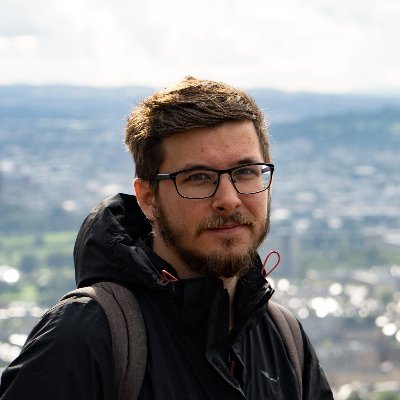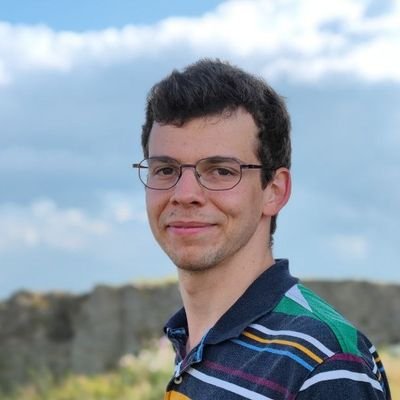
Artem Lomakin
@LomakinAI
Followers
371
Following
315
Media
32
Statuses
97
Postdoctoral scientist @StanfordCancer | PhD @emblebi and @DKFZ | studying how cancer cells are evolving in spatial context
San Francisco, USA
Joined July 2018
The wonders of population genetics allow us to reveal the echoes of the tumultuous times our ancestors survived, forever imprinted in our genome. In this thread, I'll share my experience replicating one of my all-time favourite papers by @lh3lh3 and @richard_durbin
11
116
377
How much does your medical history reveal about your future? As a team effort of @MoritzGerstung and @ewanbirney's labs, we present Delphi-2M, a transformer for modelling future health based on past medical history. https://t.co/dZP1UuvvB7
2
20
48
Recently visited SF's @exploratorium (an awesome place, highly recommend). The oscillators section mentioned the synchronisation phenomenon in fireflies but used metronomes as a demo. Metronomes are fine, but they don’t glow! Here’s a simulation of 150 fireflies shoved into a box
0
0
7
Stumbled upon some of the @ALCrego_ 's motion art and felt an urgent need to animate a black hole
1
0
11
Research internships have been essential in helping me find my career path. However, most internships in Europe are unpaid, making them inaccessible for many students. If you can, please consider helping a friend of mine to fundraise his internship at @DKFZ
Hi everyone! I am trying to raise some money for the dream internship I got at one of the best cancer research centers in Europe. I don't need much. Please find 2 minutes and read this post! It will help me a lot. Thank you! https://t.co/OhJDAEJICM
2
2
5
Exciting news! I'm looking for talented individuals to join my soon-to-be-launched Emmy Noether group supported by @dfg_public and @UniOsnabrueck! Reach out if you're passionate about #cryoEM and #photosynthesis! https://t.co/y5hEnKcYKi
https://t.co/xZc5tpo4yE
#ScienceJobs
0
29
59
Thesis defended and my colleagues awarded me with the fancy hat 🎓 Thank you everyone who've been with me on this journey - you are fantastic scientists and friends! And thank you @MoritzGerstung and @Yates_lab for guiding me through this chapter of my life. It was fun!
2
3
35
Histopathology image as a QR code v0.1
0
0
12
The field of spatial genomics has faced challenges with diverse data types and a lack of standardised infrastructure for quite some time. Congratulations to the authors for the release of a much-needed solution!
1/9 Excited to share #SpatiaData, a framework for representing spatially-resolved omics technologies. Great colab w/ @g_palla1 @ky396 @ivirshup @HeidariElyas @TreisTim Marcella @rahulbshrestha @harald_voeh @wolfgangkhuber @MoritzGerstung @notjustmoore @fabian_theis @OliverStegle
0
1
6
It took me numerous evenings of dedicated effort to replicate the task at hand. As someone with limited computational experience four years ago, I cannot stress enough how much of an underestimation the "three weeks" suggestion was 🤦♂️
1
0
26
During my PhD interview with @Nick_Goldman, I shared this as my favourite paper, acknowledging my limited understanding of how the method works. Nick then asked me how long it'd take to replicate if the math is provided, and I somewhat naively replied, "I guess three weeks?🤔"
2
1
8
A little story at the end. Why did I spend time on this instead of working on my thesis? Well, partly because this method is just awesome. Partly because I really wanted to play with HMMs and EM. But also, because I made a promise to myself at the beginning of my PhD to try.
1
0
11
By correlating inferred population sizes with archaeological data, it's tempting to speculate about causality. E.g., did the use of 🔥 or increasing 🧠 volume aided the recovery from the bottleneck 1M years ago? However, as with any model, 𝗡𝗲 is to be interpreted with care
1
0
4
In contrast, the ancestors of African populations (🟥) had remarkably different histories, resulting in a decline in effective population size concurrent with their relatives' migrations to Eurasia. The Toba volcanic eruption is among the hypotheses to explain this phenomenon.
1
0
4
Approximately 150,000 years ago, the history of the selected individuals' ancestors diverged. The noteworthy bottleneck experienced by all migrating populations (🟦) was surprisingly similar, despite the vast distances between their descendants.
1
0
5
It's evident that all humans shared similar history until approximately 150K years ago, surviving a significant bottleneck around 1M years ago. This bottleneck appears to be embedded not only in our DNA but also in fossil records. Climate change may be a factor, among others.
1
1
10
Now the fun part – what could real genomes tell? I run PSMC on the chromosomes 1-5 for six individuals: three of diverse African origins (San, Mbuti, and Maasai), a European (French), an East Asian (Japanese), and an Austronesian (Ami). Genome data is from https://t.co/AfUivFaXza
1
0
7
At first, I tested it on 300 Mb synthetic data, roughly the size of the 1st chromosome. Results look similar to the paper, with pitfalls such as low accuracy on time intervals before ~10K years and above ~2M years, and oversmoothing of rapid step-like population size changes.
1
0
7
I've implemented PSMC in numpy (with a bit of numba) to at least somewhat match the speed of the original C code. Translating from math notations to code was not as simple as I expected, some bugs took me several days to catch You can find code here:
github.com
A reimplementation of a classical PSMC method in python for educational purposes - tulerpetontidae/psmc-python
1
0
15






